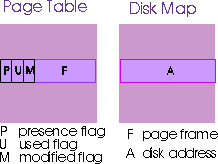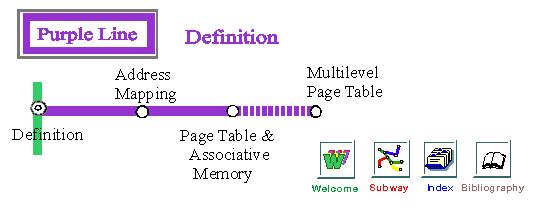Page Tables

IMPLEMENTATION OF SWAPPING IN VIRTUAL MEMORY
Each address space within the system has associated with it a page
table and a disk map. Each of these two tables describe an
*entire* address space. The page table identifies which pages are in
main memory, and in which page frames those pages are located. The disk
map identifies where all the pages are on the disk. The entire address
space is on the disk, but only a subset of it is resident in main
memory.

(Note: additional flags may also be
present, but these are the significant ones.)
If the P flag in the page table is set, the page is currently in
main memory. Its location in memory is determined by the F value; F is
the number of the page frame in which the page is located. If the P
flag is clear, the address mapper will
generate a page fault if a process attempts reference to the page; the
page fault handler will use the disk map to locate that page on the disk
and swap it in. Each address space must have a complete mapping on disk
(i.e. the entire addess space must be available on disk). In the event
that a process is swapped out entirely, none of its address space will
be in main memory; all of it will be in secondary storage. The set of
pages shown in the page table as present are a subset of the pages on
the disk. Those with the M flags set are not exact copies any more and
must be copied back to disk before they can be deleted from main memory.
It is possible to combine the page table and disk map by adding the
disk address field to the page table:

But this is generally not done
because it makes the page table bigger and may slow down address
translation. An address space on disk is implemented as a file. A file
of the address space's size is created and identified as a virtual
memory:
d = CREATE_VM(file)
The Create
Virtual Memory routine creates the necessary support structures for the
space and returns a pointer, d, that identifies the virtual memory.
Thus, a process having virtual memory d would use page table PT[d]
and disk map DM[d]. When the process exits, the operating
system must remove the address space from disk and the page table using
the command
DELETE_VM(d)
Address space
id's and process id's are not synonymous. Several threads
(different process id's) can be operating in the same address space
(same address space id); they all use the same page table and disk map.
When a page is to be swapped in, the system locates a
candidate frame from the list of page frames. Normally, the
least-recently-used (LRU) frame is
considered to best candidate. The frame number is used as an index into
yet another table the system maintains: the frame table. The
frame table describes how the main memory is being used; thus, there is
only one frame table for the entire system. Within the frame table,
there is one slot for each page frame in main memory. Each slot
identifies the address space (d, from above) using the frame and the
page, x, of that address space within the frame.
(d,x) = FRAMES(y)
y = PT(d,x)

Note that the frame
number, F, from the page table points to a frame in main memory. The
disk address A in the disk map points to a disk sector that contains the
page in the on-disk copy of the virtual memory.
When a page
fault occurs, the page fault handler procedure is invoked in the address
space of the faulting process. It's overall job is: "make the missing
page present". When it returns, the faulting process retries the
addressing operation that just failed; now it will succeed.
The job "make the missing page present" consists of these
steps:
1) Using the replacement
algorithm, get the number of a frame that will be used for the
incoming page: y = REPLACE.
2) Swap the page
currently in frame y to its slot on the disk; that slot is
DM[FRAMES[y]].
3) Swap the requested page x from its slot on
the disk into frame y; that slot is DM[d,x].
4) Update
the page table entry PT[d,x] so that P=1 and F=y, and update
FRAMES[y] to (d,x).
5) Return.
Steps 2 and 3 involve
an interaction with the disk driver. The protocol for this has been
described previously. When the step is started, it will not complete
until the disk has sent back its completion interrupt signal. Since
these steps involve swapping, it is worthwhile to eliminate one or both
of them whenever possible.
Step two may be skipped if the
identified page frame has not been modified (written to) since it was
loaded or last written to disk. As a result, when identifying candidate
frames, the system will give preference to unmodified pages.
Step three can be eliminated in case the requested page is
still loaded in main memory. This can happen if the replacement
algorithm marks the page as not present, but the owner process refers to
it again before it is swapped out. The test for this is that PR[d,x].F
= y and FRAMES[y] = (d,x).
In step five, the processor is
returned to the state in which it was running when the page fault
occured. Often, this is not a trivial task. Refer to Tannenbaum [T1] for a superficial discussion on the issues involved.
In order to facilitate the above actions and make the
likelihood of unneeded swaps as low as possible, the main memory page
frames can be divided into four groups by the combination of their (P,M)
bits. The (0,0) frames are called the "pool" of frames ready to
be used to satisfy page faults. The replacement algorithm is
instantiated as a background process that watches for unused frames and
marks them as P=0; if a newly marked page has M=1 (frame state is
(0,1)), a request to copy it out to disk is queued up; when that request
is complete the frame is moved to the (0,0) state. With this structure,
the first step of "make page present" is simply to take the first frame
from the list of (0,0) frames. (That list must be semaphore protected
so that the caller waits until there is at least one frame in the (0,0)
state, a condition that is guaranteed because the replacement policy is
working in the background to guarantee that there are (0,0) pages.)
[D7]
--P.J. Denning and Steve Coile
Also see [D1] pp. 157-159 and
[T1] pp.89-96.






